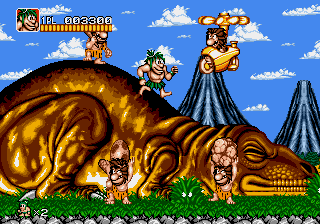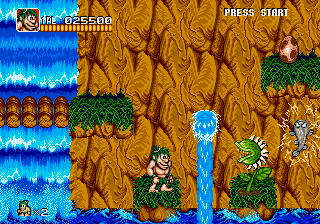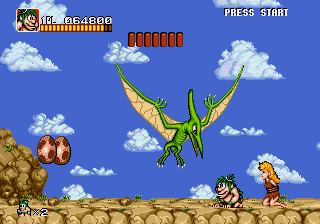Joe & Mac
From Sega Retro
| Joe & Mac | |||||||||||||||
|---|---|---|---|---|---|---|---|---|---|---|---|---|---|---|---|
| System(s): Sega Mega Drive | |||||||||||||||
| Publisher: Takara | |||||||||||||||
| Developer: Eden Entertainment Software, Krisalis Software | |||||||||||||||
| Licensor: Data East | |||||||||||||||
| Original system(s): Arcade boards | |||||||||||||||
| Developer(s) of original games: Data East | |||||||||||||||
| Sound driver: Krisalis sound driver | |||||||||||||||
| Genre: Action | |||||||||||||||
| Number of players: 1-2 | |||||||||||||||
| |||||||||||||||
|
Joe & Mac, known as Joe & Mac: Caveman Ninja in Europe and Joe & Mac: Caveman Fight (ジョーとマック 戦え原始人) in Japan, is a 1991 platforming action game by Data East. It was initially released for a Data East-manufactured arcade board, but later ported to home computers and consoles, including the Sega Mega Drive.
Publishing licenses of this version were granted to Takara in North America, Tec Toy in Brazil, and Codemasters in Europe. While the game was released in North America and Brazil in early 1994, the European version never materialized.
Contents
Story
Joe and Mac must rescue a group of cavewomen who were kidnapped by a rival tribe.
Gameplay
The game is a side-scrolling platformer with a prehistoric setting. The player can control Joe, a green-haired caveman, by starting a game through controller port 1 or Mac, a blue-haired caveman, by starting a game through controller port 2. Both characters play identically. A second player can join the game on the title screen or during gameplay by pressing START on a second control pad. Levels are short and fast-paced and end with a boss battle. Some levels let the players choose the next level after defeating the boss, though either choice leads to the same subsequent level.
Joe and Mac walk with ![]() and
and ![]() and squat with
and squat with ![]() . They jump with
. They jump with ![]() and jump off platforms with
and jump off platforms with ![]() +
+![]() or
or ![]() +
+![]() . They can perform a high jump where they curl into a ball with
. They can perform a high jump where they curl into a ball with ![]() or with
or with ![]() +
+![]() . Enemies can be defeated by jumping on top of them. In two-player games, one character can jump onto another and then pick him up by pressing
. Enemies can be defeated by jumping on top of them. In two-player games, one character can jump onto another and then pick him up by pressing ![]() +
+![]() or
or ![]() +
+![]() and throw him by pressing
and throw him by pressing ![]() .
.
Joe and Mac throw a projectile weapon with ![]() . They shoot directly upwards with
. They shoot directly upwards with ![]() +
+![]() and can also shoot while squatting or jumping. They start with throwing axes, which are thrown out at short range but quickly fall to the ground. They acquire different weapons by finding them in eggs. The weapon can be charged to a larger, longer ranged, and more powerful attack by holding
and can also shoot while squatting or jumping. They start with throwing axes, which are thrown out at short range but quickly fall to the ground. They acquire different weapons by finding them in eggs. The weapon can be charged to a larger, longer ranged, and more powerful attack by holding ![]() , though charging it for too long exhausts the character and costs health.
, though charging it for too long exhausts the character and costs health.
Joe and Mac have a health meter that goes down as they take damage from enemies. Falling down bottomless pits only costs health and bounces the characters back out. Enemies usually drop food items when they are defeated, which heal Joe or Mac when collected. Characters lose a life when they run out of health. In single-player games, the player restarts from the beginning of the level or the boss fight after losing a life; in two-player games, players have separate lives and Joe or Mac revives by falling from the sky without interrupting gameplay. Characters revert to the throwing axe weapon after losing a life. The game ends for a player when the player runs out of lives but can be continued.
Items
| Food | |
|---|---|
| Food items restore part of Joe or Mac's health and award bonus points. | |
| Egg | |
| Some enemies carry eggs, which they drop when they are defeated. Eggs can be attacked to break open and often contain a weapon item (but sometimes contain an enemy or nothing). | |
| Flint | |
| Equips Joe or Mac with flints that are thrown a short distance forward. | |
| Boomerang | |
| Equips Joe or Mac with boomerangs that are thrown a short distance and return to the thrower. | |
| Fire | |
| Equips Joe or Mac with bombs that fall on the ground. | |
| Stone Wheel | |
| Equips Joe or Mac with stone wheels that roll along the ground. |
Levels
Some levels let the player choose the next level after defeating the boss.
| Big Dino | |
|---|---|
| Water Bridge | |
| Tree (Course A) | |
| Cliff (Course B) | |
| Waterlogs | |
| Pteranodon Waterfall Ride (Course A) | |
| River Ride on Dino (Course B) | |
| First Volcano | |
| Moving Platform Volcano (Course A) | |
| Purple Floor Volcano (Course B) | |
| Fall Stage | |
| Dino Graveyard | |
| Ribcage (Course A) | |
| Lava Pools (Course B) | |
| Stomach | |
| After defeating the final boss, players are given a choice of three paths that lead to slightly different endings. |
Versions
On the Mega Drive, Joe & Mac is a no-frills arcade conversion, and while some of the graphics have been simplified, the game remains broadly the same. Its Super NES counterpart, on the other hand, is an expansion over the arcade game, featuring longer levels and more content, and a map screen similar to that of Super Mario World. The core gameplay remains identical between all versions, however.
In the arcades, Joe & Mac operates with an internal screen resolution of 256x240, which is then expanded horizontally to fill a 4:3 display. As the resulting pixels would not be square, the art assets are drawn "thin", with normal dimensions being resolved when displayed on-screen.
This is convenient for the Super NES version of Joe & Mac as its internal resolution is 256x224 (meaning the horizontal expansion is roughly the same), however this Mega Drive version operates with a native resolution of 320x224, causing almost every graphic in the game to appear too thin as the assets were not re-drawn. A side effect to this approach is that more of the play area is visible at any one time than in either the arcade or Super NES versions.
Production credits
- Written by: Tim Round
- Additional Code: Jason Stoat, Stuart Middleton
- Graphics by: Tim Round, Terry Baker, Stuart Middleton, Rob Thursfield, Lee Beckett, Rob Dorney
- Audio by: Krisalis Software Ltd
- Music by: Matt Furniss
- Music Driver by: Shaun Hollingworth
- Testing by: Phil Bradley, Lee Mather, David Fowler
- Special Thanks: Kinya Tago, Phil Bradley, Mike Brown, David Fowler, John Davies, David Powell
Magazine articles
- Main article: Joe & Mac/Magazine articles.
Promotional material
Physical scans
| Sega Retro Average | ||||||||||||||||||||||||||||||||||||||||||||||||||||||||||||||||||||||||||
|---|---|---|---|---|---|---|---|---|---|---|---|---|---|---|---|---|---|---|---|---|---|---|---|---|---|---|---|---|---|---|---|---|---|---|---|---|---|---|---|---|---|---|---|---|---|---|---|---|---|---|---|---|---|---|---|---|---|---|---|---|---|---|---|---|---|---|---|---|---|---|---|---|---|---|
|
| 64 | |
|---|---|
| Based on 14 reviews | |
Technical information
ROM dump status
| System | Hash | Size | Build Date | Source | Comments | |||||||||
|---|---|---|---|---|---|---|---|---|---|---|---|---|---|---|
| ✔ |
|
1MB | 1993-11 | Cartridge (US) |
References
- ↑ 1.0 1.1 GamePro, "March 1994" (US; 1994-xx-xx), page 58
- ↑ File:Joe & Mac MD credits.pdf
- ↑ 1700 igr dlya Sega, "" (RU; 2001-xx-xx), page 103
- ↑ Cool Gamer, "9" (RU; 2002-10-13), page 107
- ↑ Electronic Gaming Monthly, "January 1994" (US; 199x-xx-xx), page 48
- ↑ Entsiklopediya luchshikh igr Sega. Vypusk 9, "" (RU; 2002-xx-xx), page 145
- ↑ GameFan, "Volume 2, Issue 1: December 1993" (US; 1993-xx-xx), page 27
- ↑ GamePro, "March 1994" (US; 1994-xx-xx), page 56
- ↑ MAN!AC, "06/94" (DE; 1994-05-11), page 63
- ↑ Sega Mega Drive Advanced Gaming, "July 1994" (UK; 1994-0x-xx), page 22
- ↑ Mega, "February 1994" (UK; 1994-01-20), page 34
- ↑ MegaTech, "June 1994" (UK; 1994-05-19), page 22
- ↑ Sega Zone, "May 1994" (UK; 1994-04-xx), page 64
- ↑ Tricks 16 bit, "Tricks Sega Gold 800 igr" (RU; 1998-03-20), page 94
- ↑ Video Games, "6/94" (DE; 1994-05-25), page 92
- ↑ VideoGames, "March 1994" (US; 1994-0x-xx), page 79
| Joe & Mac | |
|---|---|
|
Main page | Comparisons | Maps | Hidden content | Magazine articles | Video coverage | Reception | Region coding | Technical information | Bootlegs | |




































